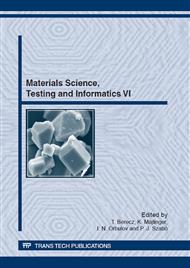[1]
S. Chakravorty, PVT testing of polymers under industrial processing conditions, Polymer Testing 21 (2002) 313–317.
DOI: 10.1016/s0142-9418(01)00089-7
Google Scholar
[2]
J. -F. Luyé, PVT measurement methodology for semicrystalline polymers to simulate injection-molding process, Journal of Applied Polymer Science 79 (2001) 302–311.
DOI: 10.1002/1097-4628(20010110)79:2<302::aid-app120>3.0.co;2-i
Google Scholar
[3]
J. Wang, P. Xie, Y. Ding, W. Yang, On-line testing equipment of P–V–T properties of polymers based on an injection molding machine, Polymer Testing 28 (2009) 228–234.
DOI: 10.1016/j.polymertesting.2008.09.003
Google Scholar
[4]
G. Menges, P. Thienel, Pressure-Specific Volume-Temperature Behavior of Thermoplastics Under Normal Processing Conditions, Polymer Engineering and Science 17 (1977) 758-763.
DOI: 10.1002/pen.760171011
Google Scholar
[5]
A. Sorrentino, L. Vertuccio, V. Vittoria, Influence of multi-walled carbon nanotubes on the β form crystallization of syndiotactic polystyrene at low temperature, eXPRESS Polymer Letters 4 (2010) 339–345.
DOI: 10.3144/expresspolymlett.2010.43
Google Scholar
[6]
M.H.E. van der Beek, G.W.M. Peters, H.E.H. Meijer, Characterization of polymers for improved shrinkage prediction in micromolding, in: W., Dimov S. (Eds. ), 4M2005: First International Conference on Multi-Material Micro Manufacture, Elsevier, Amsterdam, 2005, pp.115-118.
Google Scholar
[7]
R. Forstner, G. W. M. Peters, H. E. H. Meijer, A novel dilatometer for pvT measurements of polymers at high cooling - and shear rates, International Polymer Processing 24 (2009) 114-121.
DOI: 10.3139/217.2154
Google Scholar
[8]
R.E. Nunn, U.S. Patent 4, 850, 217. (1989).
Google Scholar
[9]
S. Rogelj, M. Krajnc, Pressure and temperature behavior of thermoplastic polymer melts during high-pressure expansion injection molding, Polymer Engineering and Science 48 (2008) 1815-1823.
DOI: 10.1002/pen.21149
Google Scholar
[10]
N. Sadeghian, M. Golzar, PVT measurement system for wood plastic composite melt in an extrusion process, Journal of Reinforced Plastics and Composites, 27 (2008) 739-750.
DOI: 10.1177/0731684407084250
Google Scholar
[11]
S.S. Park, C.B. Park, D. Ladin, H.E. Naguib, C. Tzoganakis, Development of a dilatometer for measurement of the pvT properties of a polymer/CO2 solution using a foaming extruder and a gear pump, Journal of Manufacturing Science and Engineering 124 (2002).
DOI: 10.1115/1.1418696
Google Scholar
[12]
Y.G. Li, C.B. Park, H.B. Li, J. Wang, Measurement of the PVT property of PP/CO2 solution, Fluid Phase Equilibria 270 (2008) 15–22.
DOI: 10.1016/j.fluid.2008.05.007
Google Scholar
[13]
J.G. Kim, H. Kim, H.S. Kim, J.W. Lee, Investigation of pressure-volume-temperature relationship by ultrasonic technique and its application for the quality prediction of injection molded parts, Korea-Australia Rheology Journal 16 (2004) 163-168.
Google Scholar


